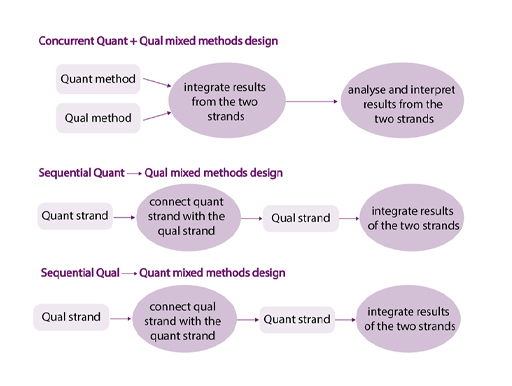2.2.2 Mixed methods research approach
In a mixed methods research approach, the researcher/team combines elements of qualitative and quantitative research approaches (e.g. use of qualitative and quantitative viewpoints, data collection, analysis, inference techniques) for the broad purposes of breadth and depth of understanding and corroboration (Johnson et al., 2016, p. 123). For example, integration of qualitative and quantitative data yields additional insight beyond the information provided by either the qualitative or quantitative data alone (Creswell and Creswell, 2018).
The rationale for mixed methods research approach is (Doyle et al., 2019):
- convergence: using quantitative and qualitative methods so that findings may be mutually corroborated
- expansion: the first phase has findings that require explanation qualitatively; unexpected findings that need to be explained
- exploration: an initial phase is required to develop an instrument or intervention, identify variables to study or develop a hypothesis that requires testing
- completeness: provides a more comprehensive account of phenomena under study.
- offset weaknesses: ensures that weaknesses of each method are minimised; caution is required when identifying this as a primary rationale as each method should be sufficiently rigorous in its own right
- different research questions: both quantitative and qualitative questions may be posed at the beginning of the inquiry in addition to mixed methods questions
- illustration: qualitative data are used to illuminate quantitative findings; putting ‘meat on the bones’ of dry quantitative data.
Three basic mixed methods designs are (Plano Clark and Ivankova, 2016) (Figure 1):
- Concurrent Quan + Qual design: a mixed methods design in which researchers implement the quantitative and qualitative strands concurrently or independent from each other with the purpose of comparing or merging quantitative and qualitative results to produce more complete and validated conclusions.
- Sequential Quan → Qual design: a mixed methods design in which researchers implement the quantitative and qualitative strands in sequence with the purpose of using follow-up qualitative data to elaborate, explain, or confirm initial quantitative results.
- Sequential Qual → Quan design: a mixed methods design in which researchers implement the qualitative and quantitative strands in sequence with the purpose of using follow-up quantitative data to generalise, test, or confirm initial qualitative results.
Mueller (2018) mentions a SoTL project by Mercer-Mapstone and Kuchel (2016) as an example of a mixed methods research approach that combined surveys, interviews and evaluations of student work to gauge student learning.
Mixed methods designs are particularly suited for interdisciplinary research, which requires collaboration across a range of disciplines grounded in a variety of research approaches.
As a part of the research design, a SoTL researcher should plan for collecting multiple types of evidence to form a comprehensive and rich picture of student learning. This approach is called triangulation of data and we will explore this further in the next section.

